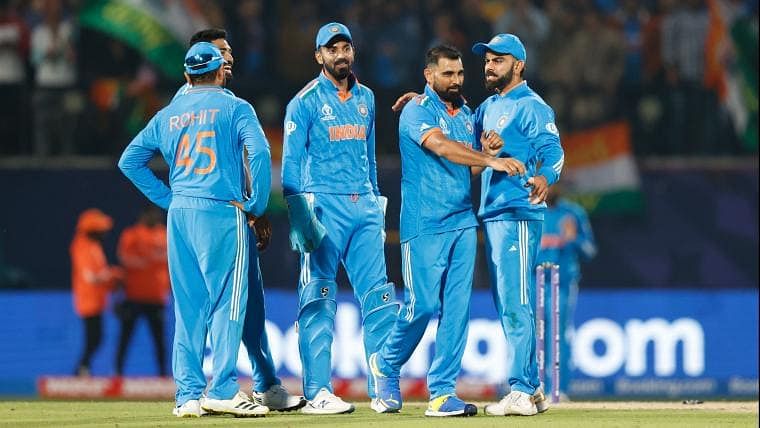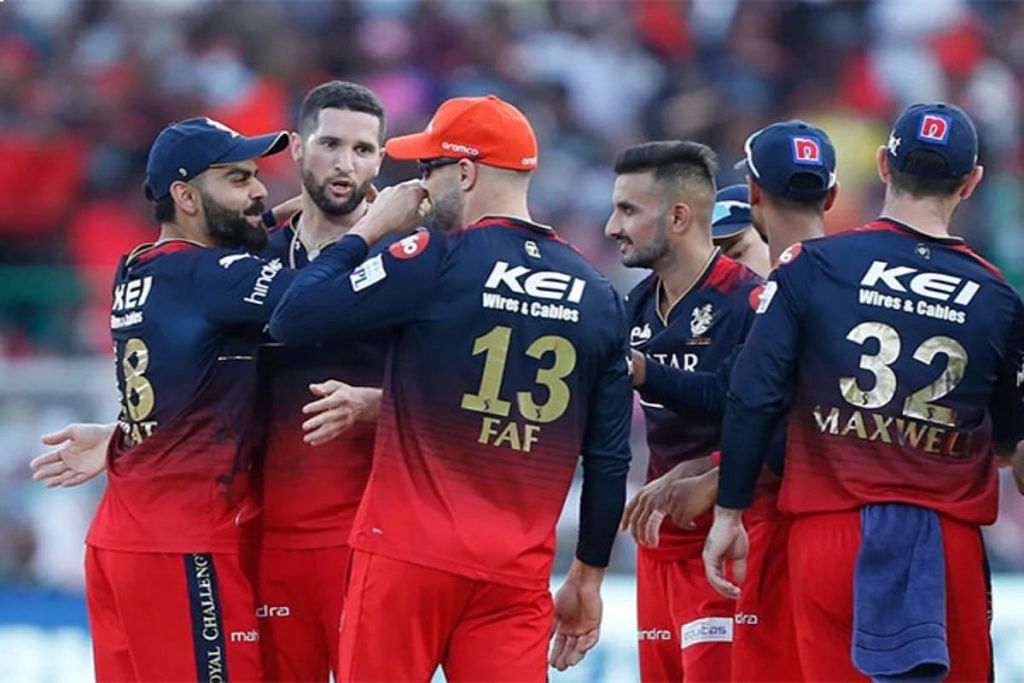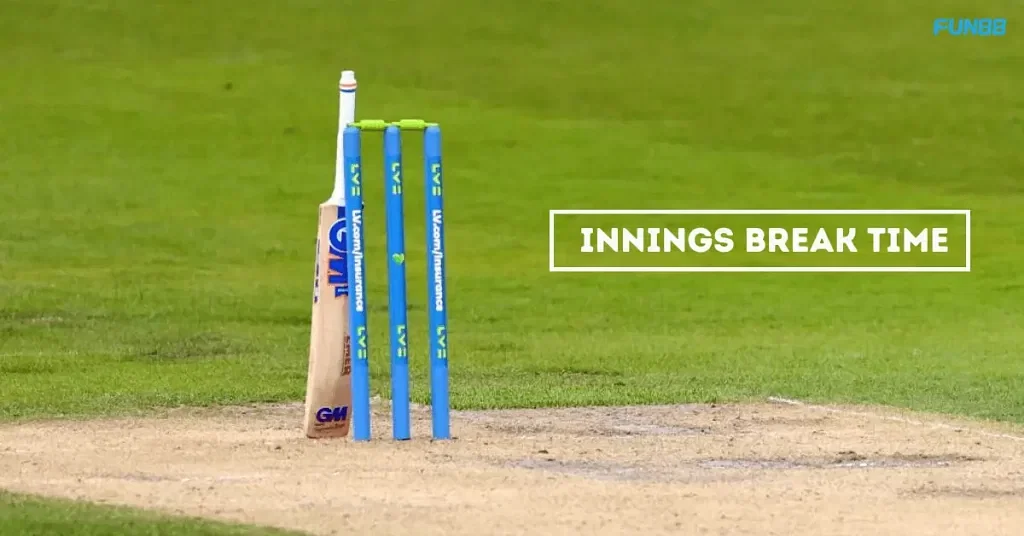Whether it is a one-day match, a quick T20 game, a big IPL tournament, a long Test match or even the World Cup, cricket games have breaks between innings. This is known as the innings break time. During these breaks, both teams take a rest, plan their next moves, and get ready to bat or bowl again.
The duration of the break depends on the kind of cricket game. In this post, we will talk about the innings break time in cricket for ODIs, T20Is, Test, IPL and World Cup matches. But first, let’s also look at why the innings break is needed in cricket in the first place.
Innings Break Time in ODI Matches
In One-Day Internationals (ODIs), the break between innings usually lasts for a maximum of 45 minutes. But there’s a catch. If the first half of the game (the first innings) takes longer than expected, the break gets shorter to keep the entire match according to the schedule.

- Minor Delay (Up to 1 hour): If the first innings loses less than an hour of playing time, the break gets shortened to 30 minutes.
- Significant Delay (2 hours): If the first inning loses more than 2 hours, the break shrinks even further to just 20 minutes.
- Major Delay (Over 2 hours): For really long delays (more than 2 hours) in the first innings, the break gets cut down to a quick 10 minutes. This makes sure the game doesn’t run too late.
As already discussed, an ODI has each side batting for 50 overs. This usually takes about 3.5 to 4 hours per inning to complete. The whole game lasts for around 8 hours. This is a lot of time to be played without a break. So, a 45-minute break is necessary for the players to get recharged.
Moreover, it becomes even more necessary for the opening batters and the batter to come after at no. 3 because the rest of the team gets additional time in the dressing room when these players are batting on the pitch.
Innings Break Time in World Cup
The ICC Cricket World Cup, which is the biggest ODI tournament, uses the same break rules as regular ODIs. The break starts at 45 minutes but can be shortened based on time lost in the first innings, just as explained above.
Innings Break Time in Test Cricket
Test cricket, known for its long matches, has a unique system for breaks between innings. Normally, there’s a quick 10-minute break between innings, but things can change depending on the situation:
- Close Call Before the End of the Day: If an inning finishes with just 10 minutes or less left before the scheduled close of play for the day, that’s it for that day! Stumps are declared to continue the game on the next day.
- Declaring or All-out: If a captain decides to end their team’s innings (declares or forfeits) during a break longer than 10 minutes (like lunch), the next inning starts at the normal time. Of course, there’s no extra break.
- Declaring or All out During Play: If a captain ends their innings during a regular break (not including the tea break) with at least 10 minutes remaining, the break still lasts its usual time and includes the 10-minute break between innings. If there are less than 10 minutes left, the next inning starts 10 minutes after the declaration or forfeit.
- Ending Close to Lunch: If an inning finishes with 10 minutes or less left before lunch due to various reasons (weather, bad light, etc.), the lunch break starts right away. It will still last for the planned time and include the 10-minute break. Unless everyone agrees otherwise, lunch always starts at the scheduled time.
- Tea Break Flexibility: If a break is already happening and there are still 30 minutes before tea time, play resumes after the standard 10-minute break, as long as conditions allow.
Moreover, this is not the end. Test Cricket goes on for 5 days at a stretch so there’s a lot of flexibility when compared to the shorter format of the game. A lot of it usually depends on the decision of the umpires on the field.
Also, one might argue that Test cricket is probably the most tiring and testing format in the sport. So, why just a 10-minute break? This is because red ball cricket has breaks like 40 minute Lunch and a 20-minute Tea. So, a larger innings break is not really needed.
Additionally, these breaks provide players with the opportunity to strategise and devise a new game plan for the subsequent session. For those unaware, a Test match is divided into 5 days, and each day has 90 overs. These overs are further divided into 3 different sessions.
The conclusion of the day’s play occurs upon the completion of the final ball of the third session. This conclusion is indicated by the umpire removing the bails from the stumps, a moment known as “stumps.”
The innings break time is purely for the top order batters to get padded up as they will be the firsts to face the heat.
Innings Break Time in T20 Cricket
A typical T20 match lasts for around three hours, with one-and-a-half hours for each of the two batting innings. The official innings break time in T20 is only 10 minutes long. This is because of certain reasons.
There are two main reasons the T20 format was created:
- Faster Results: Cricket fans craved a quicker way to enjoy the sport. T20 delivers a whole match in about 3 hours, with fast-paced action happening in almost every ball.
- Boosting Cricket’s Finances: T20 matches are shorter, which means more people can attend the games in person. This packed stadium atmosphere attracts sponsors who want to be associated with the excitement. This, in turn, brings more money to cricket boards.
So, to maintain the very essence of this format of the game, the breaks are very short. Thus, this is the very reason why one must have noticed the opening batters from the fielding side rush towards their team dressing room after the end of the 20 Overs of the first innings.
That’s all about the innings break time in the game of cricket. As you have read, the break time in each format has been decided after considering various factors like viewers’ interests, match duration, players’ endurance, strategy, pitch maintenance, commercial breaks and so on. These breaks have become a necessity for both the players and the broadcasters.
Innings Break Time in IPL
IPL innings break time just like other T20 matches, the IPL keeps things moving with a quick 10-minute break between the innings. Other than the short innings break in the IPL, a couple of strategic time-outs of 2.5 minutes each are given to both teams per inning.

Here’s why a 10-minute IPL innings break time:
- Fast-Paced Format: The Indian Premier League is designed to be quick and action-packed. A longer break would slow down the game’s momentum.
- Limited Time: A T20 match typically lasts around 3 hours, with each team batting for about an hour and a half. A short break allows for a swift transition between innings and keeps the game within the allotted time frame.
- Minimal Player Needs: With fewer overs compared to other formats, players don’t require extensive rest between innings. The 10-minute break allows them to catch their breath, rehydrate, and strategise for the next phase.
- Captain’s Address: Captains use this time to address their teams, highlighting areas of strength and weakness observed in the previous innings. They might suggest adjustments in batting or bowling strategies based on the opponent’s performance.
- Bowling Plan Adjustments: Bowlers can discuss their observations of the batsmen’s technique and weaknesses. This allows them to plan their deliveries for the upcoming innings, potentially focusing on specific deliveries that have proven effective.
Moreover, both viewers and experts are of the opinion that a 10-minute break in IPL and T20 cricket as a whole is appropriate.
Also Read: Which Player is Father of IPL?
Innings Break Time in CPL
In the Caribbean Premier League (CPL), the excitement of T20 cricket comes with its rhythms. Typically, the innings break during CPL matches lasts for about 15 minutes. This brief pause is crucial, allowing players to recalibrate while engaging fans with entertainment, reflecting the league’s vibrant ethos.
Factors Affecting Innings Break Duration
Several dynamic factors can influence the duration of an innings break. Weather is a foremost consideration; rain delays can extend breaks, requiring flexible match scheduling. Additionally, broadcasting requirements may adjust breaks for commercial timings. Moreover, logistical challenges such as venue facilities, player amenities, or special events (like ceremonies or promotions) can cause deviations. Each factor demands agile management to ensure the break duration supports player readiness and viewer engagement.
Importance of Innings Breaks for Players and Teams
For players and teams, innings breaks are more than just a timeout. Physically, this interval offers essential recovery from intense gameplay, providing hydration and nutrition to maintain performance levels. Mentally, teams must assess the game situation, revisiting plans based on pitch behaviour, weather conditions, and opposition strategies. Coaches and captains deliberate on tactics, using data analytics to refine approaches, potentially changing the match’s course during the second innings. This pause can thus be pivotal.
Impact of Innings Breaks on Match Strategy and Outcome
The strategic importance of innings breaks cannot be overstated. Captains and coaches utilise this interval to dissect opposition weaknesses from observations and statistical analyses. Pitch conditions and weather can subtly change during the break, demanding strategic shifts. For instance, alterations in bowlers’ lengths or batting orders might be necessary in light of emerging conditions or team talks. The inning break is also crucial psychologically; it can reset momentum. A team trailing in the first innings may regroup, strategising to seize control. Conversely, a leading team will deliberate on consolidating their advantage.
Cricket Innings Break Time FAQs
In T20 matches, the break between innings lasts 10-20 minutes.
In a 50-over match, the break between innings generally lasts about 30-40 minutes.
In IPL matches, the innings break typically lasts around 15 minutes. It’s a shorter break designed to maintain the fast-paced nature of T20 cricket.
In Test matches, the innings break is longer and can vary but generally lasts about 20-30 minutes between the two innings.
Star it if you find it helpful.

